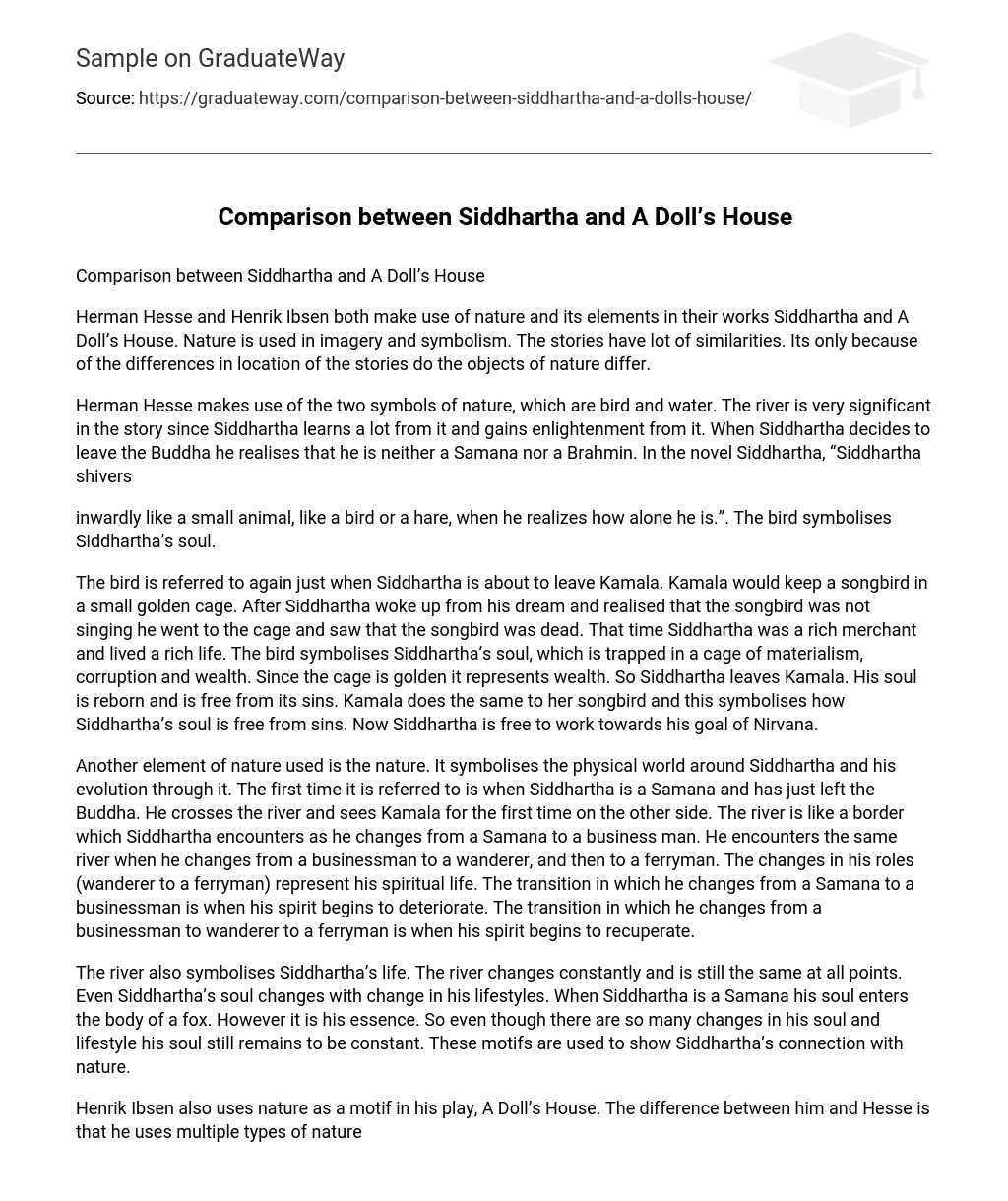Herman Hesse and Henrik Ibsen both use nature and its elements in their works, Siddhartha and A Doll’s House. They utilize nature through imagery and symbolism, resulting in many similarities between the stories. The only difference is that the objects of nature differ due to the varying locations of the stories.
Herman Hesse employs two symbols of nature, namely birds and water, in his work. The river holds great importance in the story as Siddhartha gains enlightenment and learns a lot from it. Upon leaving the Buddha, Siddhartha realizes that he does not belong to either the Samana or Brahmin groups. In the novel Siddhartha,” he shivers.
Siddhartha feels inwardly like a small animal, such as a bird or hare, when he realizes how alone he is. The bird symbolizes Siddhartha’s soul.
When Siddhartha is about to leave Kamala, the bird is referred to again. Kamala kept a songbird in a small golden cage. After Siddhartha woke up from his dream and realized that the songbird was not singing, he went to the cage and saw that it was dead. At that time, Siddhartha lived a rich life as a wealthy merchant. The bird symbolizes Siddhartha’s soul, which is trapped in a cage of materialism, corruption, and wealth. The golden cage represents wealth. Therefore, Siddhartha leaves Kamala behind and his soul is reborn free from its sins.
Kamala does the same with her songbird; this symbolizes how Siddhartha’s soul is free from sins now too. Now free to work towards his goal of Nirvana.
Another element of nature used in the story is the river. It symbolizes the physical world around Siddhartha and his evolution through it. The first time it is referred to is when Siddhartha, a Samana who has just left the Buddha, crosses the river and sees Kamala for the first time on the other side. The river acts like a border that Siddhartha encounters as he changes from a Samana to a businessman. He encounters this same river again when he changes from a businessman to a wanderer and then to a ferryman. These changes in his roles represent his spiritual life, with his transition from being a Samana to becoming a businessman marking the beginning of his spiritual deterioration while transitioning from being a businessman to wanderer and then ferryman marks him starting on recuperating spiritually.
The river symbolizes Siddhartha’s life, constantly changing yet remaining the same. As Siddhartha’s lifestyle changes, so does his soul; when he becomes a Samana, his soul enters the body of a fox, but his essence remains constant. These motifs illustrate Siddhartha’s connection with nature.
Henrik Ibsen uses nature as a motif in his play, A Doll’s House. However, unlike Hesse, he employs multiple types of nature imagery to create a unified motif.
The motif in the play is used to depict how women were treated in society and the struggles they faced. Helmer symbolizes societal norms, while Nora represents women in society. In Act 3, Nora reveals to Helmer that she had been patiently waiting for eight years for something glorious, referring to his realization of her problems. However, Helmer fails to understand her perspective, creating a significant gap between them. This lack of understanding leads Nora to leave him in the end, despite always being his skylark” whom he envisioned flying carefree through life.
Helmer also refers to Nora as his singing bird.” Nora is portrayed as a beautiful bird with exceptional singing abilities, but she is trapped inside a cage. Ibsen uses this comparison to illustrate how women are not treated equally in society compared to men and are given inferior statuses. Women may possess talents similar to those of songbirds, but they are unable to exploit their skills because they are confined within societal constraints.
Helmer expects Nora to obey him without question and denies her simple pleasures such as macaroons. Consequently, she has no choice but to indulge secretly. Despite this, Nora loves Helmer deeply and even borrowed money for him when he was ill. However, Helmer was against it, so she had no choice but to deceive him.
Helmer uses Nora to increase his prestige. When she tells him that she has taken out a loan, he becomes worried as it goes against societal expectations and could ruin his reputation. However, when he realizes that the loan has been deactivated, he calms down and returns to normal. Nora once again becomes his songbird,” and he believes that she can conform to society’s expectations once more.
In his play, Ibsen mentions a river that represents death. He describes the river’s conditions as black, cold and icy.” This is due to Nora’s state of mind, as she wants to commit suicide in the river to escape her debts. Until now, Nora has followed society’s norms, but her death would symbolize an end to these norms.
Dr. Rank is a close friend of Nora and Mr. and Mrs. Torvald. Sadly, he is dying from an illness passed down from his father, caused by his love for oysters. The oysters from the river were the culprit behind Rank’s condition.
Siddhartha and A Doll’s House both utilize nature imagery as motifs, but the themes they convey differ. Siddhartha’s use of nature imagery is spiritual in nature, reflecting the culture of a distant land. In contrast, A Doll’s House uses these motifs to highlight societal conventions and the treatment of women during that time period. This theme remains relevant in today’s world as similar issues persist.
Sutej Tilak Sharma
Grade 11





